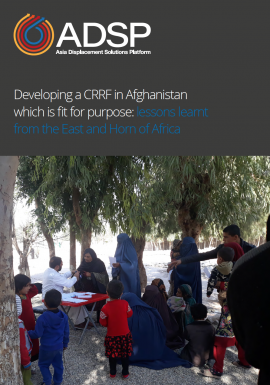Developing a CRRF in Afghanistan that is fit for purpose: Lessons Learnt from the East and Horn of Africa
The New York Declaration for Refugees and Migrants, unanimously adopted by the United Nations General Assembly in 2016, sought to respond to protracted refugee situations by providing additional support to refugee-hosting countries to promote refugee integration. It aimed to further integrate development and humanitarian actors, and to promote a ‘whole of society’ approach, addressing displacement from its onset, and mitigating the impact of protracted refugee situations.
In order to operationalise the New York Declaration, UNHCR was tasked with developing its annex, the Comprehensive Refugee Response Framework (CRRF) which envisaged responding to large-scale refugee crisis through the application four key pillars:
1) Easing pressure on host countries
2) Enhancing refugee self-reliance
3) Expanding access to third-country solutions
4) Supporting conditions in countries of origin for return in safety and dignity
To date the CRRF has been rolled out in several regions that are currently affected by large-scale refugee situations, including the East and Horn of Africa and Central America. Much of the progress which has been made to date to operationalise the CRRF has been seen in countries in East and Horn of Africa. It should be noted that each country has taken different approaches, and, have therefore achieved varying levels of success. Several studies and analysis documents have been written setting out the CRRF’s ambitions and participating countries’ progress towards their achievement. This paper does not therefore provide a precis.
In the summer of 2018, Afghanistan – alone in the region – signed up as a CRRF pilot country. To date, little has been done to develop the parameters of Afghanistan’s CRRF; given the lack of innovative policy development in the Afghan displacement axis. This should be considered as a potential missed opportunity, and one which should be rectified. As several countries are now some years into their implementation of the CRRF it is appropriate to take stock of their experience, and to reflect upon what lessons can be brought to Afghanistan.
In mid 2019, the ADSP conducted a series of interviews with key stakeholders representing INGOs, policy development bodies and the United Nations (UN), in order to identify areas of best practice which should be considered when developing Afghanistan’s CRRF response. Interviewees had a wealth of experience working in various African nations including Kenya, Somalia and Ethiopia. As part of the interview, they were asked to reflect upon their specific country of expertise, and to discuss strengths and weaknesses in the respective nation’s CRRF response.
The full report can be viewed here.

